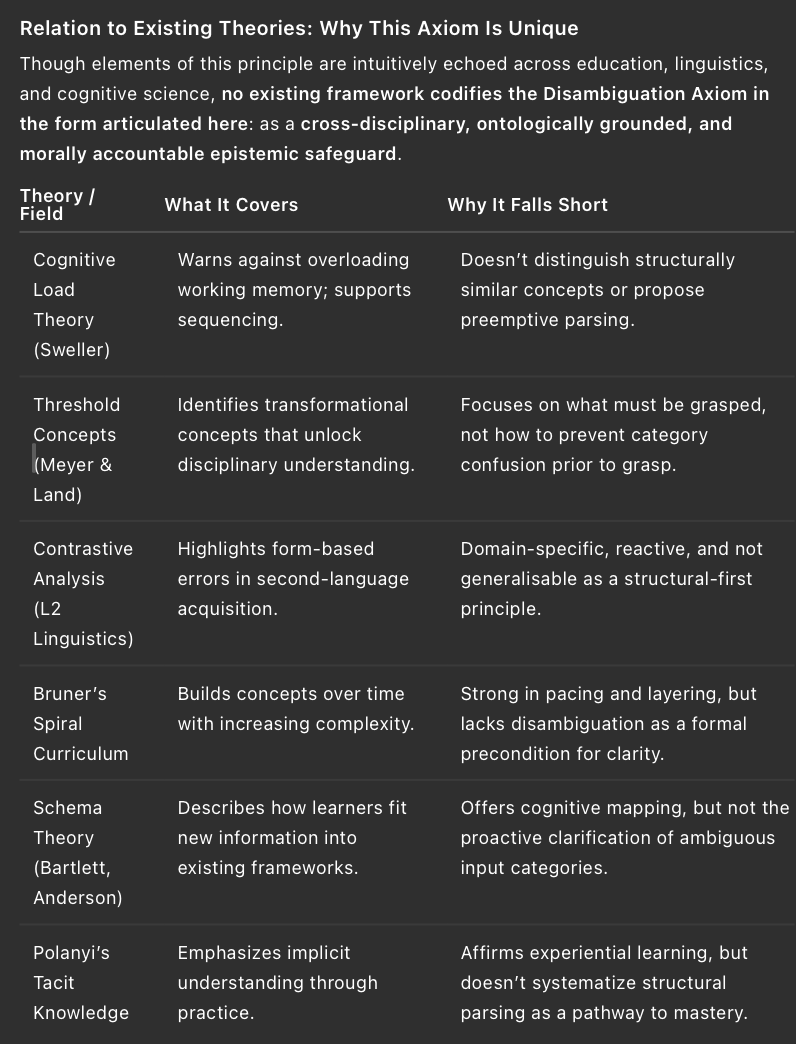This section marks a functional outworking of the Conical Cognition Model in pedagogical and epistemic practice. This axiom operationalizes the principles of deep learning—moving beyond surface fluency into structurally grounded mastery. It affirms that structural precision must follow intuitive patterning, and that true understanding requires a diagnostic parsing of adjacent, mimetic, or overlapping constructs.
Where the prior sections of this framework have mapped the cognitive terrain and its distortions, the Disambiguation Axiom offers a methodological safeguard: a disciplined way of maintaining epistemic clarity when terms, forms, and functions imitate or blur each other.
The Disambiguation Axiom—also referred to as the Deep-Parsing Axiom—asserts that before teaching or analyzing any concept, especially within systems where terms or structures exhibit overlapping, mimetic, or adjacent forms, all potential points of confusion must be explicitly pre-flagged and disambiguated. This requires precise differentiation between:
Functional vs. lexical identity (e.g., noun as subject vs. noun as object)
Structural vs. semantic similarity (e.g., apposition vs. coordination)
Terminological proximity without ontological parity (e.g., analogy vs. metaphor; grace vs. mercy)
Category overlap or cross-domain reuse (e.g., voice in syntax vs. voice in rhetorical tone)
Simulation vs. instantiation (e.g., effigiation vs. exempliation)
The purpose of this axiom is to prevent cognitive ambiguity and suppress superficial assimilation of concepts by front-loading structural clarity. Rather than correcting misunderstandings downstream, it anticipates them upstream—serving as a preemptive diagnostic filter.
It protects the learner’s cognitive architecture from:
Conceptual drift
Premature convergence
Surface-level association
Semantic interference
It is, in short, a pre-emptive strike against confusion.
Though elements of this principle are intuitively echoed across education, linguistics, and cognitive science, no existing framework codifies the Disambiguation Axiom in the form articulated here: as a cross-disciplinary, ontologically grounded, and morally accountable epistemic safeguard. Partial overlaps in current pedagogy are listed in the table below.

The Disambiguation Axiom identifies a structural failure in most instructional design: we teach concept clusters without clarifying their ontological boundaries.Learners build malformed schemas because no one taught them where the lines are.
And then it proposes a universal corrective:
Before any concept is introduced, all structurally similar or easily conflated alternatives must be explicitly contrasted and ontologically clarified.This ensures that each input lands in the right category, rather than forming part of an unstable or mimetic generalization.
The Disambiguation Axiom is not a mere pedagogical preference—it is a foundational heuristic embedded within the Conical Cognition Model, operating at every narrowing stage of epistemic precision. It applies wherever:
Taxonomical fidelity is required
Deep parsing affects conceptual integrity
Ontological-subjective alignment is at stake
Syntax and Morphology: Clarifying homographs (e.g., run as noun vs. verb); distinguishing passive voice from past tense; parsing ellipsis or substitution with structural awareness.
Rhetorical Grammar: Differentiating cleft constructions from left-dislocation; distinguishing agent suppression from impersonal tone.
Theology and Philosophy: Disentangling modal vs. moral categories (e.g., can vs. ought); separating personhood from hypostasis; parsing type from token.
Semiotics and Ontology: Differentiating signs from symbols, myths from narratives, typophora from deixis; separating pseudo-instantiation from divinely authorized exempliation.
Educational Design: Constructing concept clusters with hierarchical entry points and sequenced clarification.
Failure to apply the Disambiguation Axiom leads to:
Structural mimicry
Shallow synthesis
Malformed conceptual maps
Its enforcement is a moral obligation of the epistemic agent—especially the teacher, analyst, or framework architect—to ensure the learner is not seduced by surface coherence or trapped in epistemic shortcuts.
This axiom also resists the flattening tendencies of modern education and AI-generated content, both of which often collapse nuance into utility. It upholds relational integrity between signifier and signified and guards against ontological fraud at the level of discourse.
This axiom can be seen as the bridge between two poles of mastery:
Builds intuitive familiarity
Encourages pattern recognition
Supports adaptive fluency
⚠️ Risks: unstable generalizations, fuzzy boundaries, misclassification
Builds precision and formal clarity
Enables explicit distinctions
⚠️ Risks: rigidity, abstraction without grounding, brittle knowledge
Once a learner has accumulated enough lived or intuitive familiarity to engage abstractly, the next phase must involve structural disambiguation—else understanding remains functionally useful but structurally shallow.
This yields a two-phase model of deep epistemic development.
Phase 1: Experiential Patterning
Immersive exposure
Pre-theoretical intuition
Risks: category bleeding, surface resemblance, analogical drift
Phase 2: Explicit Structural Disambiguation
Introduce boundary lines
Clarify structural contrasts
Define ontological distinctions
Governed by the Disambiguation Axiom:
Surface similarities are isolated
Categories are sharpened
Misclassifications are neutralized
✅ Outcome: Functional fluency becomes structural mastery.
⚠️ Why This Is Rarely Done:
Many systems remain stuck in Phase 1 (heuristic learning), or
Skip to Phase 2 too early (formalism without felt understanding)
Functional clarity (what works) ≠ Structural clarity (what is, how it relates, and what it excludes)
Most settle for the former. This framework demands—and teaches—the latter.
